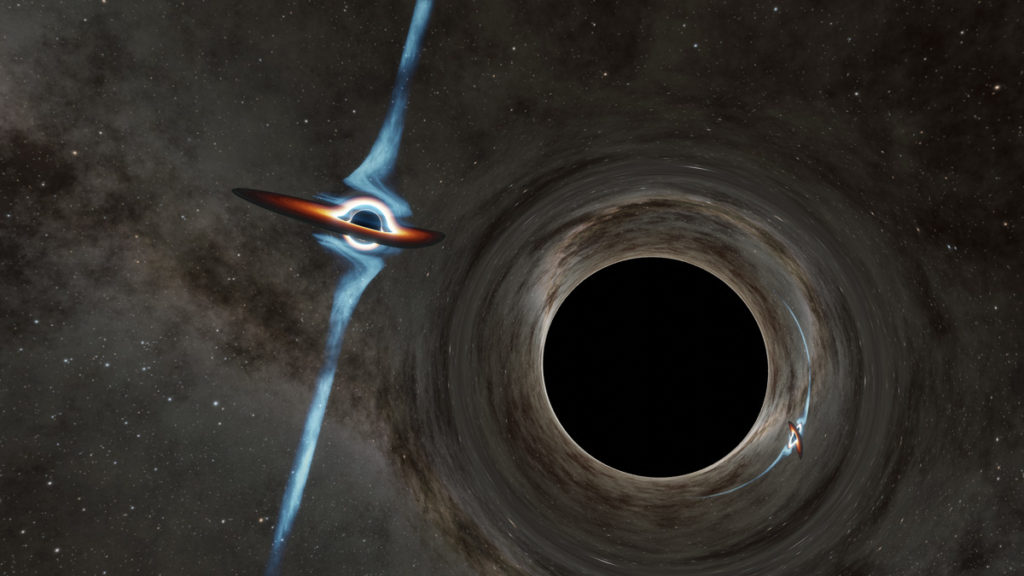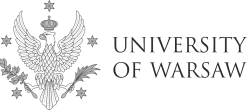Colossal Black Holes Locked in Dance at Heart of Galaxy
An international team of astronomers found evidence for a unique pair of supermassive black holes orbiting each other in the center of a quasar. Dr Przemysław Mróz from the Astronomical Observatory of the University of Warsaw is one of the co-authors of the study published in The Astrophysical Journal Letters.
Caught in an epic cosmic waltz 9 billion light-years away, two supermassive black holes appear to be orbiting around each other every two years. The two massive bodies are each hundreds of millions of times the mass of our sun and span a distance roughly fifty times the size of our own solar system. When the pair merge in roughly 10,000 years, the titanic collision is expected to shake space and time itself, sending gravitational waves across the universe.

Artist’s impression of the supermassive black hole binary at the heart of PKS 2131-021. Credit: Caltech/R. Hurt (IPAC).
An international team of astronomers has discovered evidence for this scenario within a fiercely energetic object known as a quasar. Quasars are active cores of galaxies in which a supermassive black hole is siphoning material from a disk encircling it. In some quasars, the supermassive black hole creates a jet shooting out at near the speed of light. PKS 2131-021 belongs to a subclass of quasars called blazars in which the jet is pointing towards the Earth. Astronomers knew that quasars could possess two orbiting supermassive black holes, but finding direct evidence for this has proved difficult.
Reporting in The Astrophysical Journal Letters, the researchers argue that not one but two supermassive black holes in PKS 2131-021 are orbiting each other. The tell-tale evidence came in the form of a light curve that spans 45 years. According to the study, a powerful jet emanating from one of the two black holes within PKS 2131-021 is shifting back and forth due to the pair’s orbital motion. This causes periodic changes in the quasar’s radio-light frequencies. Three different radio observatories registered these oscillations: Owens Valley Radio Observatory (OVRO), the University of Michigan Radio Astronomy Observatory (UMRAO), and Haystack Observatory.
When we realized that the quasar has been showing periodic variations for the past 45 years, we knew something very special was going on, says Przemysław Mróz of the Astronomical Observatory of the University of Warsaw, a co-author of the study who was responsible for mathematical modeling of the light curve of the quasar. Quasars usually show stochastic variability, but this one has a nearly perfect sinusoidal light curve unlike anything observed from quasars before.
According to the new report, the PKS 2131-021 candidate black holes are 2,000 astronomical units apart, about 50 times the distance between our sun and Pluto, and orbit each other every two years. (An astronomical unit is the distance between Earth and the sun.)
All galaxies are known to possess monstrous black holes at their cores, including our own Milky Way galaxy. When galaxies merge, their black holes “sink” to the middle of the newly formed galaxy and eventually join together to form an even more massive black hole. As the black holes spiral toward each other, they increasingly disturb the fabric of space and time, sending out gravitational waves, which were first predicted by Albert Einstein more than 100 years ago.
The LIGO and Virgo observatories, in which astronomers from the University of Warsaw are involved, detect gravitational waves from pairs of black holes up to dozens of times the mass of our sun. However, the supermassive black holes at the centers of galaxies are millions to billions times the mass of our sun, and give off lower frequencies of gravitational waves than what LIGO and Virgo can detect. Networks of telescopes that observe pulsing, dead stars—called pulsar-timing arrays—are able to pick up the gravitational-wave signals of supermassive black holes of this heft. But so far, no gravitational waves have been registered from any of these heavier sources. The present pair provides the most promising target yet.
We know a few confirmed binary supermassive black holes and the newly-discovered object is the tightest-knit supermassive black hole duo observed to date, says dr hab. Szymon Kozłowski from the Astronomical Observatory, who is an expert on quasar variability. This is an extremely exciting and unique object!
Credit: Caltech/R. Hurt (IPAC).




